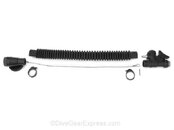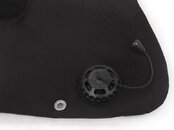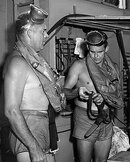Deep South Divers
Contributor
I would place the emphasis on “SHOULD never need to ditch weight at depth”. I guess we agree that dumping weight is for emergencies that SHOULD never happen, but we all know can and do, albeit rarely.
Why?
Let's say that a diver experiences a total out of gas situation with no buddy present... When this happens, is he/she not already neutral? If not (let's say that he/she was laying on the bottom), does it not make sense that the diver should simply swim up and do an emergency swimming ascent? Does it not make more sense to solve the problem by being properly weighted to begin with, rather than attempt to fix the overweighting issue by ditching at depth - with a possible uncontrolled ascent as the likely result - during the gas emergency?
Here is where there is some distance between us. I have regularly practiced free ascents since my first Scuba class in the early 1960 as do many people trained in that era or in the Navy.
I assume that by "free ascent" (a "free ascent" simply means that you're not on a downline or anchor line), you mean "emergency swimming ascent" or "controlled emergency swimming ascent" - that is, you swim to the surface as if you're out of breathing gas without any redundant supply. The idea of this, of course, is to train a diver to face a possible DCS hit in lieu of drowning. No doubt - I would choose that over drowning, too!
I, too, have been trained in controlled emergency swimming ascents, and while I very rarely practice them (physiologically, it's unhealthy), I agree with you that they do amazing things for the psychology of the diver and his/her confidence level.
...But a CESA is not an "uncontrolled bouyant ascent." My argument is that, given the situation that you're using, a diver SHOULD perform a CESA. At no point should a diver practice an uncontrolled bouyant ascent by ditching weights at depth.
More specifically for others reading this, the accepted standard for freedivers is neutral at 20 Meters/66' or the target depth, whichever is shallower. The objective is to be positively buoyant through most of the water column as a partial safety measure against SWB (Shallow Water Blackout) and to minimize the workload (save O2) at the most critical part of the ascent.
Right. So if the freediver is positively bouyant by design to address the possibility of shallow water blackout, then why would he also consider ditching his weight at depth?
Not sure I understand. There are no ill-effects to a freediver that makes a very buoyant ascent from depth. Look at the competitive standards for the No-Limits class for Apnea divers. I think that most freedivers disagree with this assessment and view dropping their weight belt as the recommended procedure whenever there is concern of a blackout of serious disability.
In the No-Limits class, support divers are available for Apnea divers. There is also a weighted sled that takes them to depth, and once the depth is achieved, the diver opens a valve which inflates a lift bag that takes him to the surface. By comparison, ditching weights - and many No-Limits, Apnea divers don't wear weights at all when they ride the sled - would have little effect. The argument about "ditching weights" for a No-Limits diver is completely moot, and not at all what scuba divers are talking about when they mention "ditching weights at depth" anyway. At best, the subject is simply a tangent of interest, and not pertinent.
Regardless of the source, you don’t need to dump weight when you have breathable gas. Nobody is discussing that. When visibility is bad, your buddy can’t be found quickly enough, and/or it all hits the fan; do you recommend passing out and sinking to the bottom until rescued?
Of course not. I recommend swimming up. I recommend a CESA, in accordance with both your and my training. I recommend maintaining control and ascending immediately. As an OOA diver ascends, he'll get another breath as ambient pressure decreases, although I'm not sure that in a CESA the diver would notice.
During a CESA, a diver - who was either neutral or nearly neutral when the OOA occurred - will experience the expansion of the bubble in his/her BC anyway... That is, the CESA diver becomes more and more positively bouyant as he gets closer to the surface anyway... No ditching required.
In fact, I believe that it can be argued successfully that an OOA diver would not want to take the few precious seconds to ditch weight. Not only is it pointless (because the diver will get progressively more bouyant anyway), but time consuming, where mere seconds count.
Other than developing the initial skill and maintaining it as a reflex, I think we are largely in agreement when it is appropriate use to dump weight.
Well, I'd love to agree with this point, but as much as I hate to use the word "never," I would actually consider it when talking about ditching weight at depth. Do you still feel that we are largely in agreement?
Unfortunately the options for divers who don’t are to panic and die, pass out trying to decide what to do, or kill themselves trying to make a free ascent they lack the skill and emotional preparation for.
Well... If they're taught to swim up, they'll get another breath every 33' or so, even if the tank is dead empty... While becoming progressively more positively bouyant as they ascend. Why teach them to ditch their weight at depth and attempt to solve a weighting issue right in the middle of an OOA? This seems dangerous, time consuming, and distracting from the real problem - their next breath.
Unfortunately, most divers have not invested enough thought or training to make this possible. Panic causes far too many people to get stupid and kill themselves. You might find this post interesting if not the entire thread: Panic in the experienced diver?
Thanks... Checking it out...







